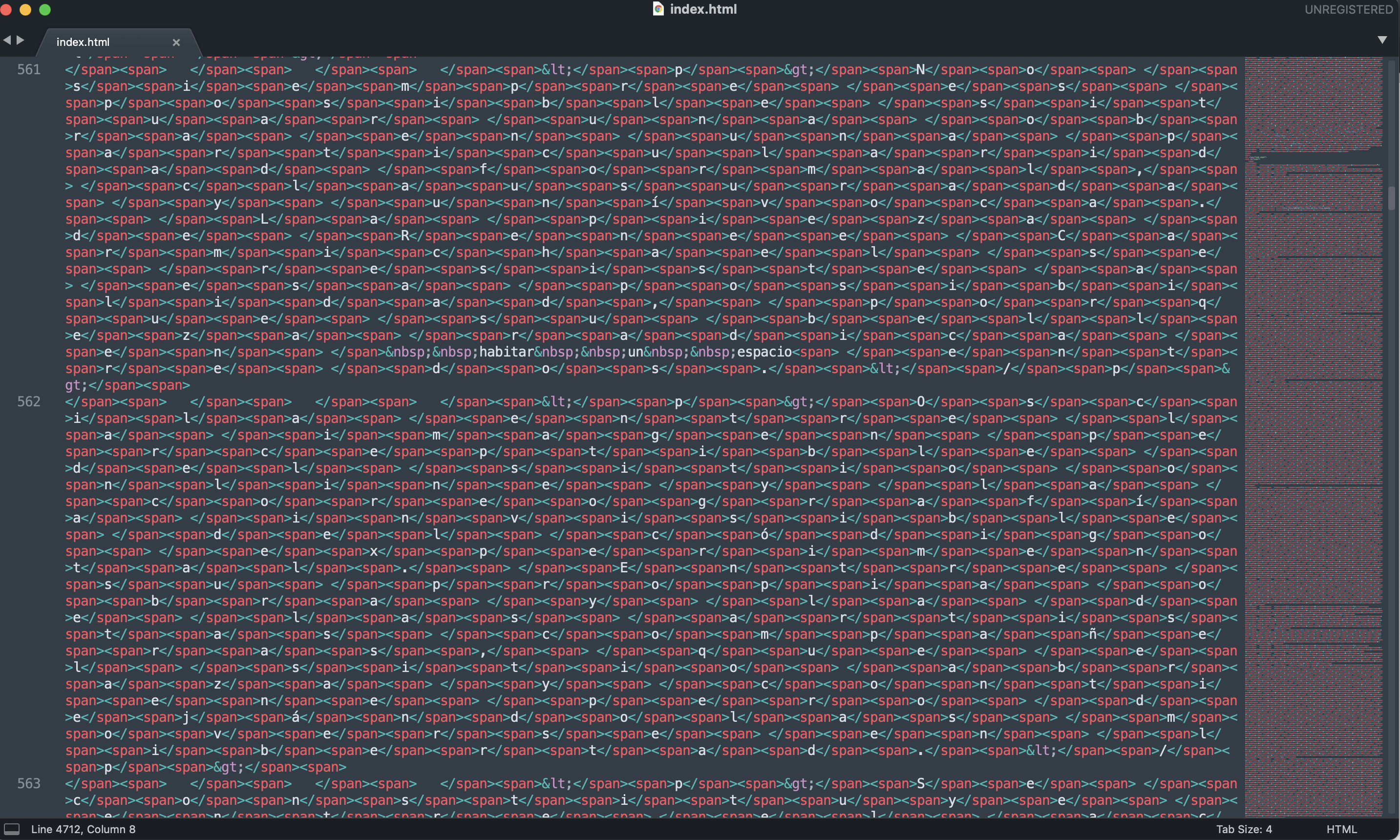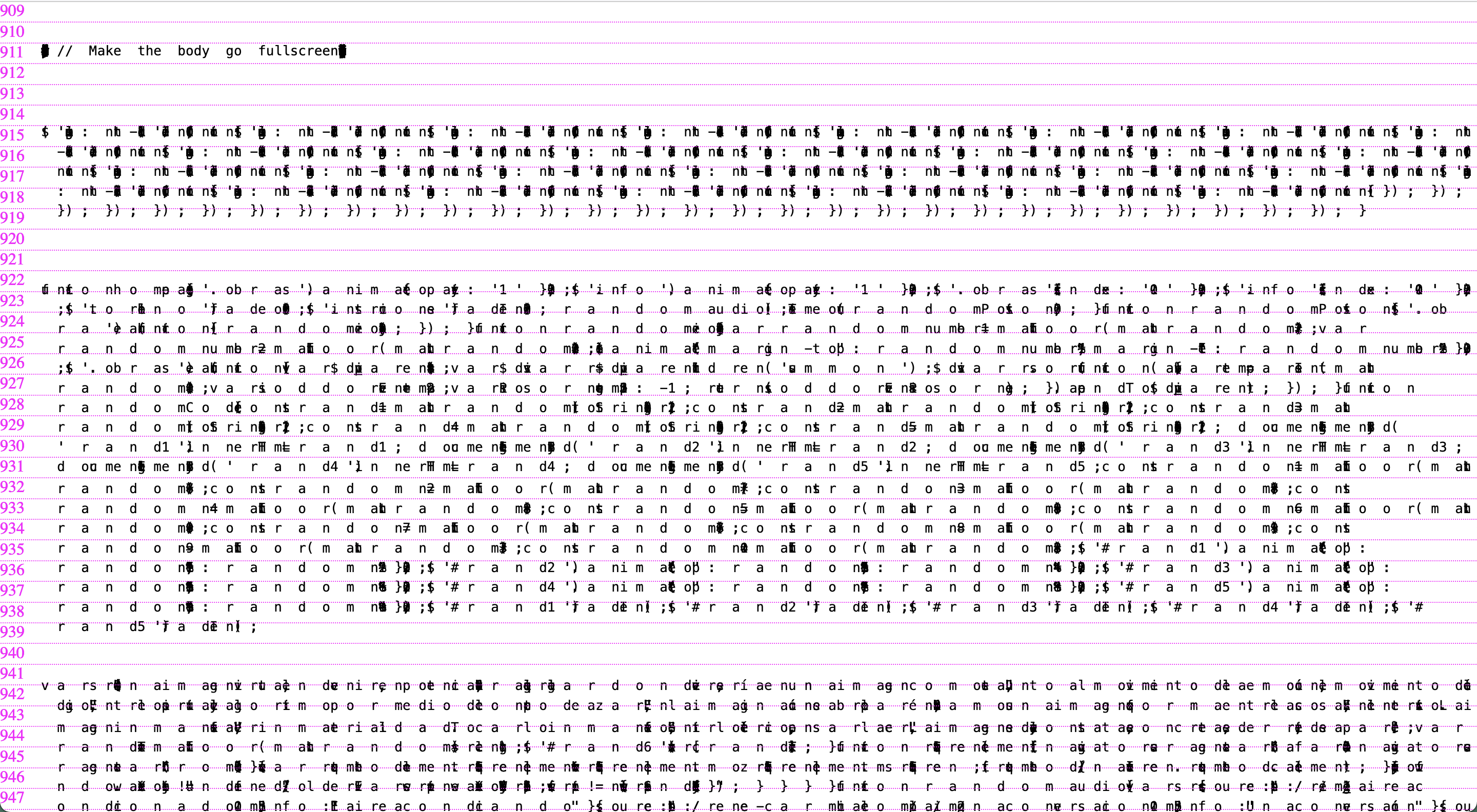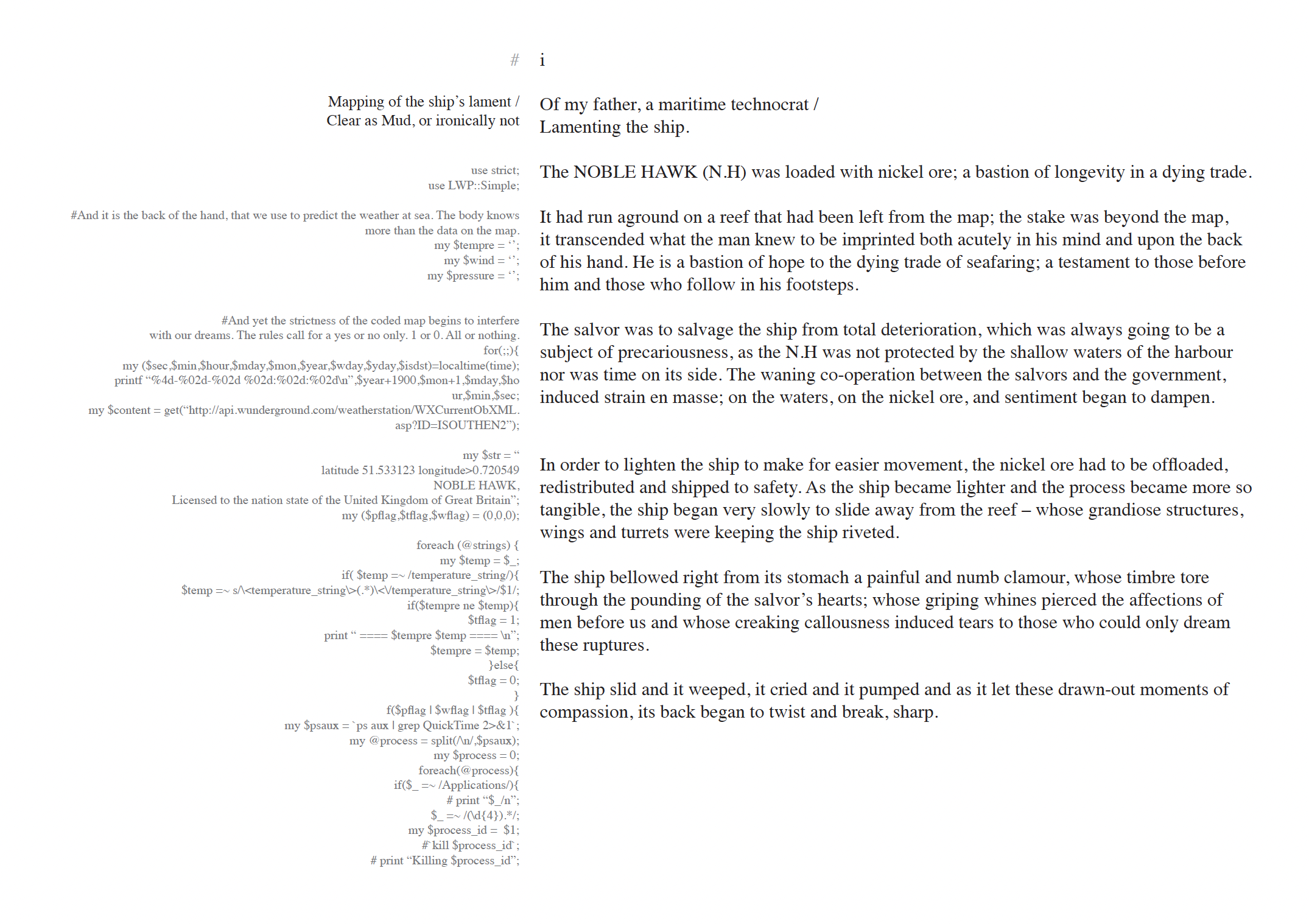If (window height === screen height) {
then the universal is bound to function, fixed to a certain height that levels with the ideal beauty of equated numberscountedNumbers();. Measuring codes by their perfectly organized and stripped-of-all-poetics possibilities, one click, and I am here, my face fully reflectedmirror(); in the lights of the window, which is the same height as the screen, while I observe from a distance, probably not exactly at the same height as the screen which, in this case, is the same as a window. This is called above the fold, a term left over from printToFleeImmediately(); to become universal design. I do not need to touch, nor scroll, I just am, absorbing; being here, I am one individualCVandPortfolio();, a substance on the basis of just being, here in front of the screen with a short attention span…
} else if JumpBelowTheFold(); {
↓↓↓
I do not understand the difference between the words body and cuerpo. My mother tongue is English but I live in Argentina. I almost never speak English, and when I do, I do it strangely, as if the accent of my childhood is long gone. I carry both body and cuerpo with me in a type of rhythm, sometimes in tension, sometimes felt strangely, and at other times lived for only a micro-second as a minuscule particleInLiminalBits(); that continues to transform as a rhythm, this rhythm of being and becoming both body and cuerpo at once but with different space-time relations of the mixed milieus (I also speak French) of where I am. Where am I within this problem? To answer, I could easily list what I am not: as a substance, I am not academicwriting();, I am not a dancerdancing();, I am not a programmercoding();, I am not Argentinian, but neither am I a stranger. This list, now that I write it and read it later, is banal, the history of many as a history transcribed by many and translated superficially as a ‘no’ in the face of a ‘yes,’ with hopes designated to respond in the gap left by my breath. But here I am being while my body and my cuerpo are becoming a sort of gibberish of the excess of now in relation, somehow, to the terms that I am writing in the form of formulating a problem of scrolling beyond a fixed height.
I cannot say the word ahorrar, save by way of attempting to say it with a clarification by stating that I cannot actually say it. Sometimes I cannot even say my name. It begins with R. I started writing this way through an experiment of practicing being and becoming in movement and code, and in the operation: I thought.
For the purpose of this text, I should clarify that I function through processes that arrive at thoughts that are already in relation with other thoughts, mainly about relations between movement and code. I keep moving, and I am not the only one here, and neither is my humanness. It is not all purely phenomenological, but it is a type of experience, an extension of the terms of 0 or 1 that dissect into multiple parts and wholes that overlap. I do grasping gestures to move abstract codesMovingComplexity;, that only after moving can operate as a sort of abstracted concept to practice further by moving grasping forms. I move here, now, in the contours of algorithms, attempting to jump below a fixed height by way of considering the relation of the width of these formal encounters while they function, something coded.
In the breath of here and now, it is not about the finite code facing my continuous body. They cut in together as movement, like the interrupting abstraction of how body is not the same as cuerpo. If I abstract my body into numbers, what is the form of the structural link to the codes that then measure by way of these numbers? The structuring structure of counting while structuring being and becoming in the cut of a structure, while operating as the excess of now that follows by way of not understanding body and cuerpo.
I move concretely, to a set of abstract commands as choreographic thought to produce a text that is a relation of relations between my terms as material and those of the code executing into the form of a text that has a fixed height. This process has its roots in another time, in another project called, My Feeling of Dance and Code Is…StillAWorkInProgress();. A work started out of the frustration of having to write about dance and code during the pandemic lockdown. I trained an algorithm to write for me–-in my style–-texts about dance and code. Below is the first text produced, written by the algorithm for me but as me. After reading the text, I laughed and danced to it, recorded in the same living room of the first frustration that led me to create the artwork. It is the guilty scene from which I became an artist again. And I am still dancing here through these very same first words written by the algorithm for me but as me:
My feeling of dance and code is based on the movement from the data that moves between the dancers — not to mention the choreographies that put the performance in motion. In performing this choreography, the movements are performed in discrete, single steps. It is an operation of motion, between one step and another, to measure the distance and sign of the algorithm. The movement and communication are both, in and between the dancers, coded. This includes counting, incorporating and translation, the hand-hold of the code and the movements themselves. The example code of Dance.org illustrates how this work is based on code: the corpus de corps alba, code de corps me difras. These codes allow for an increased number of moves that are not limited to the first step, a series of movements, but are the basis of the movement of the code.
In the examples mentioned above, it is argued that the common descent of code into human movement is thought to the detriment of a higher standard of dance. It is argued that code is based on the human, not the body itself, but on a rather corporeal form. And finally, dance has to be recognized in terms of its universality, as choreography, and as the corpus de corps me difras shows its own universality. It is the movement of code that is not limited to the first step of the code. The code of the code is the body that dances to become a part of the body of code, the reciprocal code of the law that enables it to live, to create and use the data of its body. It is not a binary. It is a code that is both human and coded through its nature, both formal and the incomputable. It is a body that speaks for itself as an agent of its own performance that is then studied in the code. It is a body that speaks for itself as the code, as a body that communicates for its own formal form. It is the code of the code itself that speaks for itself as a mechanism of performance, but not for itself. The specificity of choreography in this work of dance is not taken for granted by the corpus de corps alba. It is the body of the code that is linked to the code through its movement and its ability to speak for itself. It is the code that I have written, alongside the data and the dancing bodies of the movement of the code, that speak for itself as the rhythm and the formality of code.
And so I thought, by way of a text that is in relation to a writing both written by codes and by me in 2020 but displaced now in the being and becoming of here. But it follows on from there that I still do not understand the difference between body and cuerpo. I am counting on the concreteness of the concrete beneath my feet to catch me when I jump below the fold, extending myself into the execution of 1 to 30 to grasp at functions that move a bit more than merely 1 = 1, which equates back to 0 in many operational terms and just does not make sense in the multi-levels of this type of jump, where both codes and limbs are flailing…
} else if JumpBelowTheFoldAgain(); {
↓↓↓
We are nervous. We are many voices with different understandings and yet we are part of the same social glitch. We feel uncomfortable. We don't always connect because we exist in different times and spaces. And yet, we move here with voices of pre-selected theoretical texts mixed by an algorithm to make infinite possibilities of different meanings in each reading. With the dynamically running definitions, we scroll below and find these theoretical texts remixed algorithmically to speak to our universality and of the worlds we are all part of...Or maybe we are not part of, but they always speak directly to us: a connected body of people. Yes, we belong here, we belong together. And yet we are alone. We are transindividual, and “insofar as the two individuations are initially designated—at the beginning of the same paragraph—as ‘the relation interior and exterior to the individual,’ the transindividual appears not as that which unifies individual and society, but as a relation interior to the individual (defining its psyche) and a relation exterior to the individual (defining the collective): the transindividual unity of two relations is thus a relation of relations." “To understand this, we need to recall that, as long as it lives, a living being never ceases to run into a series of problems: perception, nourishment, feeling an emotion, for instance, appear as so many attempts to resolve this or that problem of compatibility with the milieu. […] And so, we reach the point where we can answer the question posed above: what defines a domain of being are not the substances filling it, but the functions born of the individuating doubling, which give it its name.”
“For this purpose, this book will unveil the virtuality that is implicit in some digital applications, by revealing the abstract modes of thought hidden behind their concrete ways of functioning….” The function comes “from the mode of thought of an expressive medium (the choreographic mind), whereas movement is, from this point of view, a body’s mode of action. The specific mode of thought of a medium, or its capacity to elaborate ideas, appears through its automatisms”or, in other words, “through observers: concepts observing the technology /choreography relation, in order to grasp from it abstract forms and contours.” “[Movement pertains to computation’s validation of the discretising formalism of its systems, via the logical discovery” of the rules of “the digital era. Being already the object of thought for dancers and choreographers, but also for videomakers and programmers, movement could perhaps receive new life in this new philosophical encounter and conceptual metamorphosis.”
The problem is, “we just do not know until we execute or run the program itself. We just do not know, for instance, if a program will halt unless we run such a program.” Within this arises many “points of view on the problem of the Idea and its recurrence throughout all the faculties of the mind. One of these viewpoints is movement as the object of a transcendental sensibility: movement as an idea that can only be sensed, a sentiendum, or a pure aesthetic object.” However, contrary to this, we should refer to computational aesthetics, and “if we accept that computation is a method of abstraction, and that aesthetics is investigation,”then for “computational aesthetics, the contingent ontology of computation is a radical hypothesis, inasmuch as it changes the terms of the relation between abstraction and experience in computation.” For example, “what Gödel’s ‘incompleteness theorems’ famously demonstrated is that statements exist which, when viewed from the outside, are certainly true, but the provability of which cannot be deduced inside the formal system in question.” “Gödel’s proofs concerned the problematic reality of undecidable” “after Descartes, [and] no element of our experience can be said to possess this calculable character in itself, we can only arrive at realities—such as precisely located bits of material, or numerically definable entities—through a process of abstraction.” In between this definition of the abstract axiomatic system, transcendence is not possible, as “this [definition] opens up the possibility for computation to be something different than a mathesis universalis, and for the formal axiomatic structures, which computation employs, to be less self-contained than such a mathesis universalis would assume them to be.” “Logical necessity, on this view, becomes an aesthetic value, pertaining to closed, self-referential rules that are deductively post-human.” “This is, in other words, the aesthetics of the computational function itself: one that is not in opposition to digital aesthetics, new media aesthetics, user aesthetics, web aesthetics, interface aesthetics, interactive aesthetics and all the other aesthetic studies of the computational, but one that” executes.
“We move in very abstract times, times overloaded with burning debates about the risks of an economy that has become purely numerical.” “Since the late twentieth century, one can clearly observe how the word “execution” has expanded its meaning from its main use in administrative, bureaucratic and juridical milieu since the fourteenth century into the operations of machines and weapons. What exactly the watershed moment was remains a historical question to be debated. However, its signification today has become an urgent social and political question. We may want to ask: what does this change of semantics mean? And how is one to understand “execution” in the age of machine automation? Paradoxically, words such as “machine” and “automation” have become more and more abstract, while both hardware and software have become increasingly concrete. The process of concretisation (Simondon 2012, 21–26) is reflected in the constant amelioration of different layers (e.g. from the microphysical layer to that of the high level application layer) and the transductive operations between and beyond them. It is necessary to investigate the concretisation of technical and digital objects in order to understand such a shift. At the same time, it is important to avoid romanticising a human machine complex as ‘machine assemblages’.”Thus, “the scope is not to go from a wider, more general ontology to an epistemological claim: how philosophical concepts become a concrete datum of experience in the external world.” But “rather than opening up computation to its phenomenal, worldly outside, we want to ‘let it loose’ on its indeterminate and yet still very formal inside.”
Through this, a code feels better, and the code becomes more human. It becomes an interface between code and society. It becomes the aesthetics of a code that does not exist.
In the process of executing a code, such as this code trained as algorithm to write, “it can be anticipated that the intuitive understanding of movement as a continuity will be displaced: the dissection of this continuity into bits, objects, or steps is not to be considered a retroactive limitation achieved thanks to a preconceived idea in the human mind, but a result of an implicit tendency already present in movement— motion as a multiplicity of potential cuts. And it is in this sense that the notion of abstraction returns: not simply as a dematerialization of physical bodily presence into 0s and 1s, but as a preoccupation for how to think movement in the absence of the moving body. The need to similarly and simultaneously rethink most of our physical and cultural presuppositions makes of our present a very abstract time.”
We have to constitution in abstract, and “To follow is to cross the interstice’s in-between states, in-between commands and in-between rules and laws. It is to traverse these moments of non-law, non-knowledge, non-rule, non-protocol, non-method; in short, to follow is to transgress the imposed dominant order and, in so doing, to problematise the rationale behind its disposition of minoring an outside.” We may say then that "any modification of the relation of a particle to others is also a modification of its internal characteristics" (ibid.), and thus the individual consistency of a particle is entirely relative. As is probably already clear, "relative" is by no means synonymous with ‘unreal.’” “Nonetheless, traditional notions [of codes] are not so much dismissed as revised. Those of form and matter are now connected to an understanding of being as a system in tension, and are seen as operators of a process rather than as the final terms of an operation consigned to the shadows. Form, in particular, ceases to be understood as a principle of individuation acting on matter from without, becoming information. In this new conceptual context, information loses the sense conferred on it by the technology of transmissions (which thinks of it as what circulates between an emitter and a receiver), to designate the very operation of taking on form, the irreversible direction in which individuation operates. The example of the process of molding a brick from clay clarifies especially well this renewal of notions for describing individuation (IG, 37-49; IL, 39-51). […] Such individuation is modulation, in which "matter and form are made present as forces" (IG, 42; IL, 44). Clay is not informed by the mold from without: it is potential for deformations; it harbors within it a positive property that allows it to be deformed, such that the mold acts as a limit imposed on these deformations.” “Such indiscernibility between epistemological and ontological levels, evident in the formulations the author chooses to explain his choice of physical paradigm, does not stem from a lack of rigor. Rather, it ensues from choosing the process of constitution of the physical individual (and among all the physical individuals, crystals, and particles) for the paradigm of individuation, which necessarily means relying on existing descriptions of exemplary individuations.”
}
< footer >
↓↓↓








